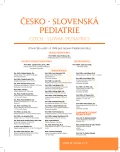RSV infection in late preterm infants
Authors:
K. Maťašová; M. Zibolen
Authors‘ workplace:
Neonatologická klinika JLF UK a UNM, Martin
Published in:
Čes-slov Pediat 2017; 72 (3): 201-205.
Category:
Review
Overview
Lower respiratory tract infection caused by RS virus is an important medical problem. It affects predominantly preterm infants during the first months of their life. Due to the severity of the disease they often require intensive care. RSV infection can have a long-lasting negative impact on the lung function in infants. It can contribute to development of asthma, wheezing and increase the risk of chronic obstructive pulmonary disease in adults. Currently, the only safe and well tolerated strategy to prevent the onset of RSV infection is immunoprophylaxis by monoclonal antibody in the most vulnerable patients. The incidence of severe RSV infections documented by the need for hospitalization in extremely preterm is comparable to late preterm infants and treatment with palivizumab decreases the hospitalization rate significantly especially in the late preterm infants. The decrease in incidence of RSV infections is an appropriate approach in prevention of asthma. It is supposed that approximately one third of cases of asthma can be prevented by treatment with palivizumab. The importance of the risk reduction in RSV infection development among late preterm infants underlines also the fact that they represent a very large group of newborns.
Key words:
RS virus, late preterm infants, palivizumab
Sources
1. Anderson EJ, Krilov LR, De Vincenzo, JP, et al. SENTINEL1: An observational study of respiratory syncytial virus hospitalizations among U.S. infants born at 29 to 35 weeks gestational age not receiving immunoprophylaxis. Am J Perinatol 2017; 34 (1): 51–56.
2. Zomer-Kooijker K, Van Der Ent CK, Ermers MJJ, et al. Increased risk of wheeze and decreased lung function after respiratory syncytial virus infection. PLoS ONE 2014; 9 (1): e87162.
3. Hijtenbeek RGP, Kerstjens JM, Reijneveld SA, et al. RSV infection among children born moderately preterm in a community-based cohort. Eur J Pediatr 2015; 174 (4): 435–442.
4. Stockman LJ, Curns AT, Anderson LJ, et al. Respiratory syncytial virus-associated hospitalizations among infants and young children in the United States, 1997–2006. Pediatr Infect Dis J 2012; 31 (1): 5–9.
5. Blanken MO, Koffijberg H, Nibbelke EE, et al. Prospective validation of a prognostic model for respiratory syncytial virus bronchiolitis in late preterm infants: a multicenter birth cohort study. PLoS ONE 2013; 8 (3): e59161.
6. Pike KC, Lucas JSA. Respiratory consequences of late preterm birth. Paediatr Respir Rev 2015; 16 (3): 182–188.
7. Straňák Z, Saliba E, Kosma P, et al. Predictors of RSV LRTI hospitalization in infant born at 33 to 35 weeks gestational age: a large multinational study (PONI). PLoS ONE 2016; 11 (6): e0157446.
8. Resch B, Paes B. Are late preterm infants as susceptible to RSV infection as full term infants? Early Hum Dev 2011; 87: 47–49.
9. Bloemers BL, Van Furth AM, Weijerman ME, et al. Down syndrome: a novel risk factor for respiratory syncytial virus bronchiolitis – a prospective birth-cohort study. Pediatrics 2007; 120 (4): e1076–e1081.
10. Figueras-Aloy J, Carbonell-Estrany X, Quero J, et al. FLIP-2 Study: risk factors linked to respiratory syncytial virus infection requiring hospitalization in premature infants born in Spain at a gestational age of 32 to 35 weeks. Pediatr Infect Dis J 2008; 27 (9): 788–793.
11. Carbonell-Estrany X, Fullarton JR, Gooch KL, et al. The influence of birth weight amongst 33-35 weeks gestational age (wGA) infants on the risk of respiratory syncytial virus (RSV) hospitalisation: a pooled analysis. J Matern Fetal Neonatal Med 2016; 1–7.
12. Drysdale SB, Prendergast M, Alcazar M, et al. Genetic predisposition of RSV infection related respiratory morbidity in preterm infants. Eur J Pediatr 2014; 173 (3): 905–912.
13. Simões EAF, Carbonell-Estrany X, Fullarton JR, et al. A predictive model for respiratory syncytial virus (RSV) hospitalisation of premature infants born at 33-35 weeks of gestational age, based on data from the Spanish FLIP study. Respir Res 2008; 9 (1): 78.
14. Luoto R, Jartti T, Ruuskanen O, et al. Review of the clinical significance of respiratory virus infections in newborn infants. Acta Pædiatrica 2016; 105 (10): 1132–1139.
15. Blanken MO, Rovers MR, Molenaar JM, et al. Respiratory syncytial virus and recurrent wheeze in healthy preterm infants. N Engl J Med 2013; 368 (19): 1791–1799.
16. Zibolenová J, Ševčovič D, Baška T, et al. Matematické modelovanie infekčných ochorení detského veku. Čes-slov Pediat 2015; 70 (4): 210–214.
17. Notario G, Vo P, Gooch K, et al. Respiratory syncytial virus-related hospitalization in premature infants without bronchopulmonary dysplasia: subgroup efficacy analysis of the IMpact-RSV trial by gestational age group. Pediatr Health Med Ther 2014; 5: 43–48.
18. Chen JJ, Chan P, Paes B, et al. Serious adverse events in the Canadian registry of children receiving Palivizumab (CARESS) for respiratory syncytial virus prevention. PLoS ONE 2015; 10 (8): e0134711.
Labels
Neonatology Paediatrics General practitioner for children and adolescentsArticle was published in
Czech-Slovak Pediatrics

2017 Issue 3
Most read in this issue
- Patello-femoral disorders in children
- Legg-Calve-Perthes disease
- Pepsin in secretion from the upper respiratory tract as a marker of extraesophageal reflux in children
- RSV infection in late preterm infants
